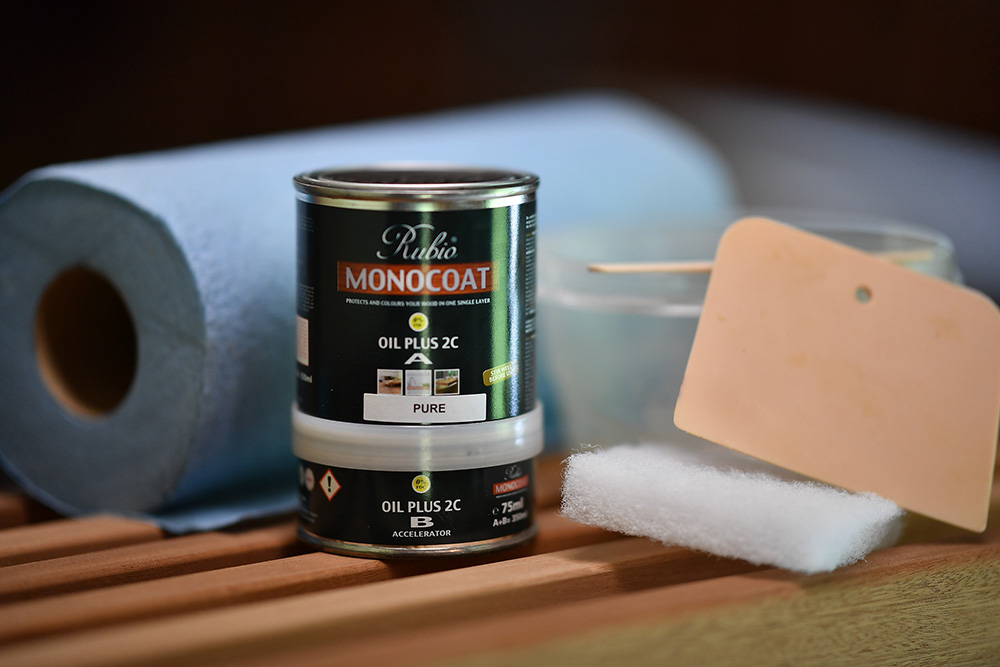Rubio Monocoat gave me some of my life back.
Like many other makers and DIYers, I’m always looking for ways to speed up my build process and utilize my time effectively. For makers, more time saved means more money in the pocket and more opportunities to work on other projects.
How do you save time when working on a project? Batching is highly effective, as is using jigs and templates to produce repeatable results. Focusing on all tasks required of a tool rather than jumping back and forth between tools (obviously there will be exceptions wherein you need to move the process from tool to tool and back again).
While milling, construction, and sanding do account for a considerable amount of the time of a project, the finishing step can be just as laborious. Ugh, sanding. Is a common mantra amongst woodworkers. It’s messy work and it takes a lot of time. Just when you thought it was over by applying the finish, guess what? You’ve got to sand between coats. Come on!!
I found a way to save time

Perusing my Instagram feed one day I came across Jeff of @jeffmackdesigns using Rubio Monocoat – an all-natural, plant-based, VOC-free, non-toxic oil wood finish – on a tabletop. Rubio is a single coat application available in 50+ colors of matte sheen, primarily used in the flooring industry. Jeff quickly covered the tabletop in mere minutes to completion and he was on to other tasks. He answered some questions and I knew I had to try it out. I was intrigued by this product.
The process of finishing with Rubio Monocoat is a simple one:
- Use a trowel or squeegee to quickly spread it
- A soft scotch-brite pad to work it into the grain
- Wipe off the excess
That’s it. NO sanding between coats. NO additional coats are necessary. It won’t reach full cured hardness for 5 days when using the activator or 21 days without using the activator. Now, this doesn’t mean you can’t handle the item, it’s basically dry to the touch once the excess is wiped off. Full curing means its resistance to abrasion and spills. The product needs about 3-5 minutes to bond with the wood fibers, then the excess can be removed (don’t let it sit more than 15 minutes though).
A little goes a long way, as the product does not bond to itself – no streaking or overlap marks either.
Of particular note is, the manufacturer recommends a final sanding of no higher than 150 grit. What?! Obviously we furniture makers are used to higher grits (220, 320 for final surface and 400 between coats). You CAN apply Rubio Monocoat to the higher grits, there’s just no guarantee from the manufacturer that it will get proper adhesion (being that it is initially designed for the flooring industry, sanding prep is much lower).
Whilst only one coat of oil is needed, softer woods like walnut or pine may absorb the oil differently throughout its grain and would benefit from a second application (it’ll use much less oil to do the second application). Give the finish 24 hours to cure before doing a 320 sanding, or abrading with a scouring pad, then clean off the dust and apply your second coat.
Alternatively, you could apply Rubio’s Universal Maintenance Oil (available in a handful of colors) and get a very slight sheen increase. *Of note, once you use the UMO you can’t spot repair with the part A oil though.
As you can see reading to this point, you’ll be saving time with less sanding, less actual sandpaper, and less labor.
You can’t afford to not use Rubio Monocoat
Rubio does cost more than a traditional polyurethane or lacquer finish ($20-30 at local home centers). Liter size is roughly $170-$220, 350ml is $70-$90 {Buy Rubio Monocoat – using this affiliate link helps support me 🙂 } That’s a huge disparity. The product does go a long way though, 300-500 sq ft of coverage depending on wood porosity.
In my opinion, for the time I’m saving in the steps of the process I no longer have to do (plus the fewer materials I have to buy from those steps) it more than justifies itself. You’re going to spend hours sanding and applying multiple coats of finish, I’d rather have that time to work on other projects or spend time with family and friends.
(This article is based on my firsthand experience using the product on several projects over the last few years and isn’t influenced by the manufacturer or anyone else.)
